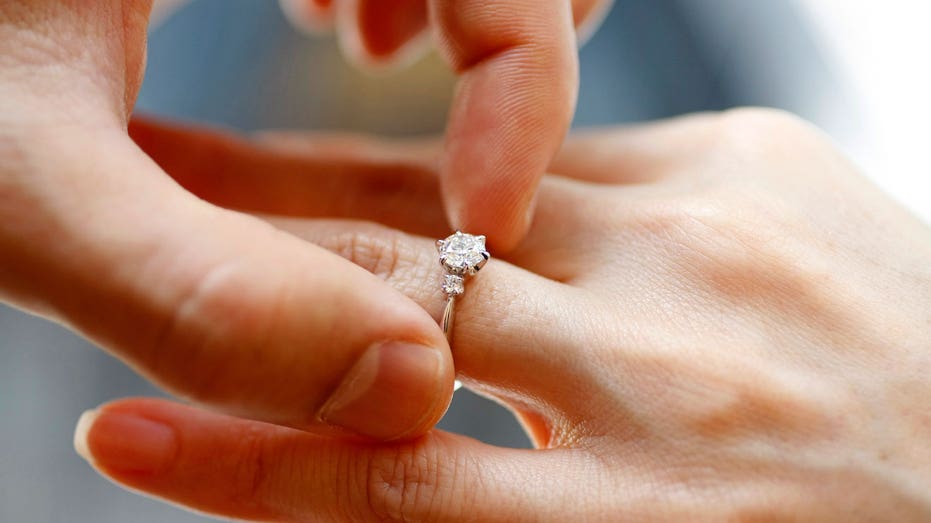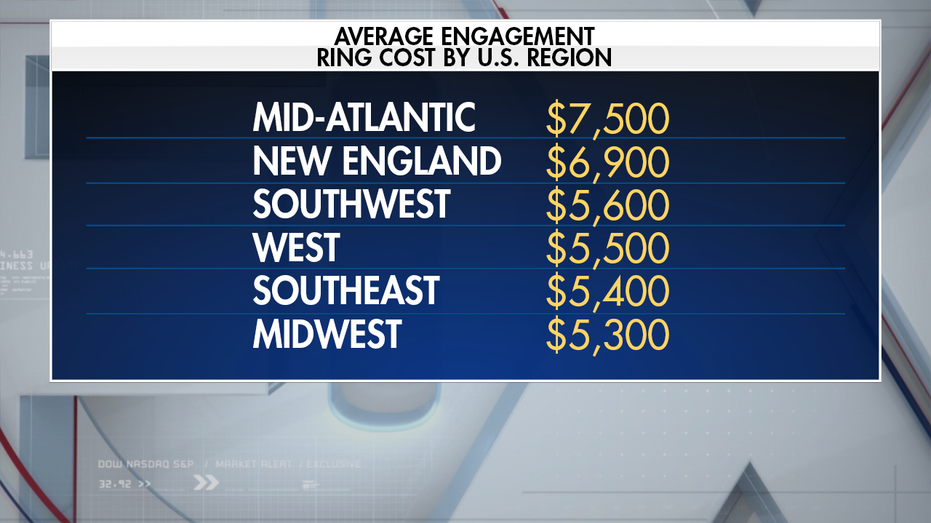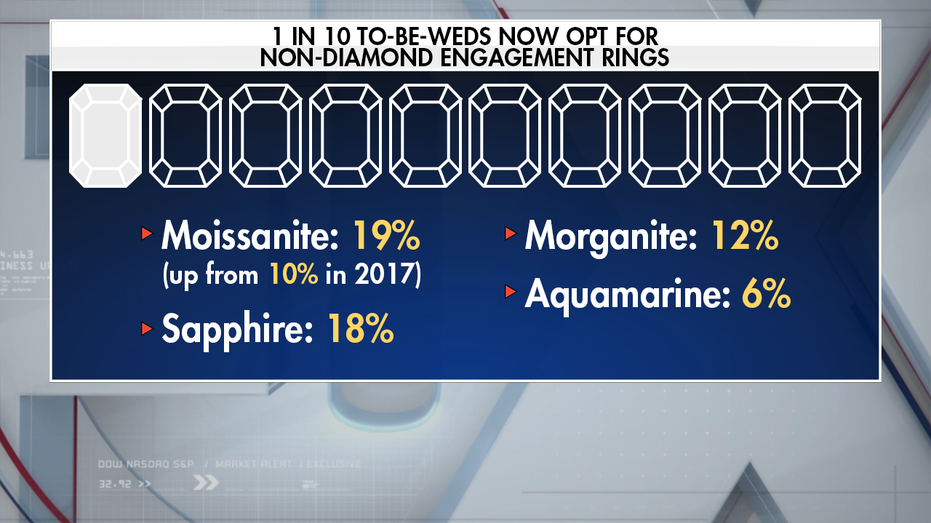Engagement-ring shopping: What you need to know before you buy that rock
Startup taking the stress out of engagement ring shopping
With Clarity CEO Anubh Shah and Clarity COO Slisha Kankariya on how the company’s business model takes the pressure out of shopping for engagement rings.
Every year, millions of Americans are ready to pop the question.
Continue Reading Below
Unfortunately for them, there's no manual on how to go about this major milestone or how to strategically shop for an engagement ring.
With the entire wedding ring market projected to grow to $402 billion by 2021, according to industry analysis from 360 Research Reports, committing cash to these pieces of jewelry isn’t for the faint of heart.
FOX Business consulted various experts in the wedding and personal finance world to get an idea of what people need to know before they make this life-changing purchase. Here are the four areas worth considering.
What do you need to know before you see a jeweler?
For those unfamiliar with how to differentiate between an engagement ring and a wedding ring, there are key differences.
"An engagement ring usually features one larger center diamond, and wedding rings are usually a circular band of precious metals with or without smaller diamonds," said Katie Zimmerman, chief merchandising officer of the online jewelry retailer Blue Nile
"It's true that the majority of the budget will almost always go to the engagement ring," she added.
However, not every ring has to break the bank.
"The good news is that there are so many options in price and style of wedding rings that you can flex to your budget," she said. "A pair of 14-karat gold bands for you and your partner can be less than $600."
And not every metal is created equal. Zimmerman broke the most popular — and long-lasting — types for anyone who is potentially shopping around for a ring.
- Platinum is strong and durable enough to last a lifetime.
- Gold is resistant to rust, tarnish and corrosion.
- Silver isn’t recommended since it does not possess the longevity that other metals have.
One decision shoppers need to make is whether or not to splurge on a name-brand engagement ring.
"Designer engagement rings have always been popular in the wedding ring category," Zimmerman said. "Designers have certain aesthetics incorporated into the ring design that is unique to each designer's collection and are not easily replicated."
"When choosing between designer and non-designer it's all about [whether] those features reflect one’s style or not," she added.
PRICEY ENGAGEMENT RINGS A NO-GO FOR YOUNGER AMERICANS
What is trending?
As the holidays approach, engagements are sure to spike. According to The Knot 2019 Jewelry and Engagement Study, 37 percent of couples get engaged between November and February. Inside the report, recently engaged couples shared how they approached engagement ring purchases.
For couples who exchanged engagement rings, 85 percent bought new rings for the occasion. Forty-five percent went a step further and opted for a custom design.
Plus, 40 percent of proposers chose a local independent retailer while 30 percent chose a national or regional jewelry chain for this important purchase. A number of couples bought the ring’s stone and setting from the same retailer. The study found that about 50 percent of engagement rings are between one to two carats in total, although one in four is more than two carats in size. Most couples are prioritizing cost and quality over the total size of a ring, according to the study. Shoppers are also taking precautions when they purchase an engagement ring, with seven in 10 couples purchasing insurance. In terms of style, round center cut stones are most popular, followed by princess or square shapes, oval and cushion, according to the report. Pear or teardrop shapes were the least popular. When it comes down to which metals are most common, more than half of respondents chose white gold while rose gold nabbed second place. Platinum and yellow gold are next on the list, followed by sterling silver. “The national average cost of an engagement ring in 2019 being $5,900, although one in three proposers spend between $1,000 and $4,000.” Diamonds are still a top choice for engagement ring shoppers with a whopping 86 percent selecting the world's hardest stone. Ten percent have chosen other precious gemstones while three percent selected with colored diamonds. One percent skipped a stone altogether. For shoppers who want to adhere to a strict budget, there are several ways to lower the cost of an engagement ring. Kristen Maxwell Cooper, editor-in-chief of The Knot, says repurposing stones or choosing a vintage ring can be cost-effective options if there are no family heirlooms available to pass down. She acknowledged that non-diamond alternatives are less expensive for comparable sizes. "While moissanite stones resemble diamonds and have great brilliance making them a highly sought after stone for cost-saving purposes, many other gemstones like sapphires, morganite and aquamarine are desired because of the fun pop of color they bring to an engagement ring," Cooper said. Those who are diamond lovers can often find a less expensive option within the lab-grown market over pricier naturally occurring ones, according to Cooper. THE $80G RING ‘BACHELORETTE’ HANNAH BROWN COULD HAVE HAD: WHAT YOU NEED TO KNOW Celebrity jeweler Jason Arasheben, the founder of Jason of Beverly Hills, has a slightly different perspective. He maintains that natural diamonds are still in high demand. "They retain their value over time, allowing people to pass them down from generation to generation," he said. Arasheben said there are color-treated diamonds available in the market, which involves lasering a natural stone for an enhanced appearance. This can be an issue if a treated diamond has the same asking price of an untreated natural one, so he stressed that shoppers need to stay vigilant. Arasheben also suggested that shoppers should research the durability of gemstones before making a purchase since not every type is fit for everyday wear. Aquamarines, green emeralds and opals as stones that are prone to chipping or breakage, he said. For the average shopper who wants to make an engagement ring have a celebrity feel, this expert jeweler to the stars has an arsenal of attainable tips. "Elongated diamond cuts like oval, can look bigger next to a similar size round, or square cut diamond. Adding a halo or two is a nice option as well," he said. There's an old saying that an engagement ring should cost around three months' salary. But Douglas Boneparth, president of Bone Fide Wealth, said shoppers should ignore this piece of advice because there are no hard or set rules. "It comes down to affordability and what your financial goals are," he said. DITCH THE ENGAGEMENT RING DURING A JOB INTERVIEW? Before heading to a jewelry store, Boneparth suggested taking time to closely look at your financial situation, research the regional going rate for engagement rings and have an open conversation about money to gauge a partner's expectations. Once that is all done, a plan can be put in place. Instead of recommending a broad expenditure percentage that can conflict with a person’s income or savings, Boneparth said that discipline is the key. This applies to both cash and credit purchases. "Create a realistic timeline and stick to it," he said. GET FOX BUSINESS ON THE GO BY CLICKING HERE People who pay for a ring in cash will have slightly more wiggle room to adjust their budget along the way. For instance, if a person wants to purchase a $10,000 ring in 10 months, they will have to save $1,000 to meet their goal. However, if unexpected expenses cause that monthly savings to drop to $750, a person can delay the purchase a few months with few consequences. This isn't the case for people who pay for a ring with a credit card or loan and need to make on-time payments. Failing to pay off a balance can result in fees or higher interest charges, so Boneparth cautioned shoppers to be careful with their service terms. Zero-interest financing promotions, in particular, are often strict. "Your life won't stop, and your responsibilities won't stop after you buy a ring," he said. "Usually, you're going to pay for a wedding, a honeymoon, maybe settle down and buy a home. Your financial responsibilities actually kind of start at that point." “You need to be cognizant of the fact that those things will continue on. And a good point here is that when you finally buy that ring, you don’t want to be left with nothing. You don’t want every penny going there. The last thing you want is to start out your life together on unstable financial footing because all the money went into a ring.” "I can assure you that people sleep a lot better at night not because there's a ring on their finger, but because they're there because they have savings in a bank," he added. "So, if you just remember that your financial life does go on, you can maybe frame your decision around purchasing an engagement ring around the fact that you also need to provide for yourself and others." CLICK HERE TO READ MORE ON FOX BUSINESS Source: Read Full ArticleEngagement ring shopping tips.
How to pay for the ring?



